

Organ : 2 keyboards , pedalboard - 21 stops
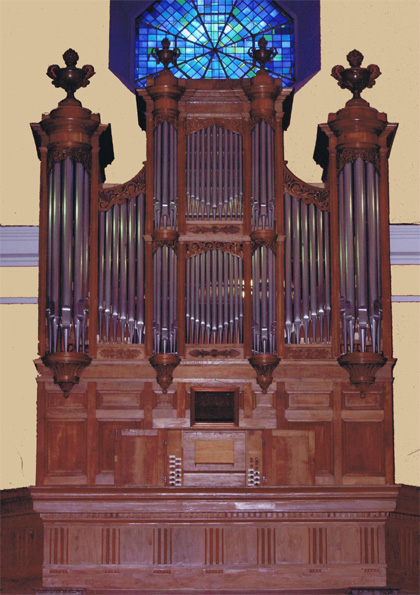
History :
The former church possessed an organ which was annihilated by the collapse of the church that very year of its construction (1699). While during the XVIIIth century, Eustache had refused to implant an organ on the gallery on the left of the choir, it is only in 1843 when the priest Davin - appointed in 1841 - makes known his desire to finalize the construction of an organ. At the end of 1844, the specifications are established by Crudère son, organist of the big organ Isnard of Saint-Cannat in Marseille.
He plans to implant an instrument of twenty stops on the trapezoid gallery recently built in 1838. This gallery is ideally raised up at 6 meters above the ground and distant from 10,5 meters of the vault's summit.
In his preliminary draft, Crudère gives a big importance at the fundamental of the organ and for the big stop, he seems on the other hand, little sensitive to the mutation stops because his composition does not include a Nazard, the Cornet contains only three ranks. Also, he lends a little importance for the pedal's division and satisfies itself with 18 pedal-keys permanently coupled with the keyboard of Big Organ.
His taste for the modernity and the romantic tones is clearly read in its preliminary draft. Besides the Gambes of both keyboards, he adds to the reed stops of the classic organ, some stops fashionable as the Cor anglais in the Récit and the Euphone in the Great-organ, doubtless with free reeds. To note also, all the planned reeds are conical reeds (no "Cromorne", no "Voix humaine").
Crudère consults five organ builders : Joseph and Claude Ignace Callinet from Rouffach, Daublaine Callinet of Paris, Chambry from Valence and Agati de Pistoia in Italy, the latter asks in a letter sent to Crudère what he means by "Clairon".
Composition :
| Grand-Orgue - 54 notes | Récit expressif - 42 notes | Pédale - 30 notes |
| Bourdon 16' | Flûte traversière 8' | En tirasse fixe sur le Grand-Orgue |
| Montre 8' | Dulciane 8' | avec laye séparée |
| Bourdon 8' | Bourdon 8' | |
| Flûte traversière 8' | Prestant 4' | |
| Gambe 8' | Trompette 8' | |
| Prestant 4' | Hautbois 8' | |
| Flûte 4' | Voix humaine 8' | |
| Doublette 2' | ||
| Fourniture 5 rangs | ||
| Cornet 5 rangs (C3 - F5) | ||
| Trompette 8' | ||
| Basson 8' (C1 - C3) | ||
| Chalumeau 8' (C#3 - F5) | ||
| Cromorne 8' | Tremblant | |
| Clairon 4' |
Appel/renvoi Grand-Jeu au pied (le Grand-Jeu actionne la Trompette, le Chalumeau, le Clairon et le Cornet au G.O.)
Shift coupler II/I
On December 17th, 1844, the expert sends to the priest Davin the results of his call for tenders, presenting favorably Joseph Callinet's project.
The council signs the contract on July 6th, 1845 with Joseph Callinet de Rouffach who has to deliver the organ in May, 1846 for 13000 francs. The official acceptance is made on April 19th, 1846, the construction, the transport, the harmonization and the agreement will thus have taken only a little more than nine months. It is at this date that "fabriciens" votes the supplies for the organist and the blower.
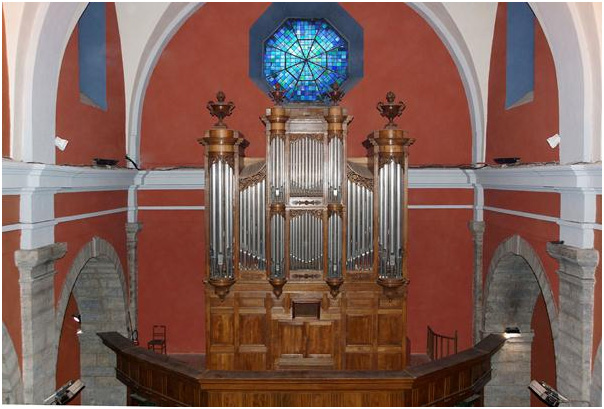
Joseph, far from Alsace, realized an instrument rather faithful to the draft. His realization, is different from that of the usual organs built by Callinet. At Solliès-Pont, the swell organ (second keyboard) replaces the traditional "positif de dos". As asked by Crudère, there is no independent pedal. Finally, 33 % of the reed stops, a stop on three, exceed clearly the 25 % traditionnally used by the organ builder.
He rethinks here his usual plan of case with four turrets, the big ones on the sides. To mask the swell box of the "Récit", he places two floors of pipes in the center and inverts the line of the mouths of the flat faces. Aristide Cavaillé-Coll will proceed sometimes also with a small facade which masks the swell box above the big facade.
Joseph reproduced this arrangement in Ste Marie au Mines (Haut-Rhin) and in Frick (Switzerland). Somewhere else, for example in Sallanches he replaces both floors stacked by one central big flat face.
In the ornamentation, we can notice the beautiful jars with flames which cap the turrets, important moldings, tailpieces decorated with thin palm leaves and pine cones. The built-in console is closed by two doors. The front face of the case is in oak (stuck on fir tree of the posts and rails),the sides, the back and the ceilings in fir tree.
It is proportionally the most expensive organ which built Joseph Callinet. For the same 13000 franc amount, an Alsatian organ would have counted thirty five stops on three keyboards and pedalboard. We can attribute this additionnal cost to the transport's expenses on about 800 kilometers.
The subscription for the payment launched by the council turned out insufficient and the organ will be paid entirely only in 1862, that is 16 years after its acceptance! When Joseph Callinet died in 1857, the debt Sollièspontoise still amounts to 10000 francs, without the interests. Finally the priest Davin lends 1000 francs to the factory in January 1862, to settle the payment of the instrument.
The arrival of the instrument in Provence had to cause a big stir because Mr Kauffmann, organist of the new organ Zeiger in Lorgues,
instrument of 43 stops on 4 keyboards builds in 1843, decides to leave its gallery to come to play the organ Callinet from 1846. The next year, saint Joseph's parish in Marseille decides to order a big organ of three keyboards and about fourty stops which be replaced later by an organ of Aristide Cavaillé-Coll.
In June, 1856, Grégori, organist of Saint-Louis of Toulon and friend of Crudère, makes a general tuning of the instrument and signs his passage on the entablature behind the layes.
In 1872, the company Puget of Toulouse, suggests endowing the instrument of a pedal independent of 27 pedal keys provided with 4 stops, standardizing the composition of the big organ and building a new windchest for a swell "Récit" endowed with 54 groove channels for 8 stops. This project which would have completely transformed the organ, will not be realized. The same year, Puget will content with practising a renovation, some small works (replacement of the shift couplers by a system with forks, replacement of the mild tremulant by a lost wind tremulant, modification of a stop (the Basson-Chalumeau is replaced by a Basson 8-16 (from C2) inserting the bass of the Basson of Callinet) and the installation of parallelisms on the reservoir) as well as retouch of the voicing and a general tuning. The signature of these works was found on one of the swell shutters of the swell box. We know that it is Mrs Eugène and Théodore that made these works from 12 till 24 August of year 1872.
In 1900, Méritan makes repairs and changes the mechanisms of the wind supply. In 1911, he makes a general tuning.
In 1945, Jean-Albert Négrel cleans the organ of the fragments of the rose window crashed by the destruction of the bridge on Gapeau. He moves back the organ to leave some space for the singers. He cuts the reservoir in two to put it in the lower case deleting by the way the system of call of the "grand Jeu" and the laye of pedalcoupler, replacing it by a mechanism under the keyboard, extending the pedalboard to 27 pedal keys.
In 1963, Négrel makes a lifting of the mechanical parts, completes the "Récit" with a pneumatic grave octave placed in the lower case, in place of one of the two reservoirs and builds an independent pedal of 3 stops: Bourdon 16 ' - Flute 8 ' - Flute 4 ' in pneumatic extension. The pedal is extended to 30 pedal keys. The composition is also modified, labels are changed, some pipe of Callinet are replaced by second-hand stops (Nazard and Tierce Récit) but also by new pipes of Schwenkedel (2 ranks of the Cymbale, the composition of which is modified). It is between the two interventions of Négrel that was installed an electric blower.
These last works of Négrel marked a disturbing drift with notches practised in the pipework, the inversions of pipes, the deletion of one of the two reservoirs and the modification of the wind supply. Nevertheless, the main part of the structure and the pipework was still there.
In 1965, Pie Meyer-Siat's masterful work on "Les Callinet" allowed to estimate better the characteristics of this organ the classification as an historic monuments will be envisaged in 1971. Claude Aubry, technician consultant came to study the instrument and Pierre Rochas realized pictures. After numerous studies and steps, the organ was finally classified on June 10th, 1983.
Couperin, G. Pierné -Hermès Vernet
Travaux de restauration :

The wind supply is certainly the part of the organ which had the most suffered of the works of Négrel. 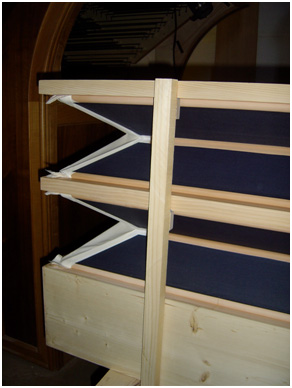
In the dismantling, the present reservoir in the lower case was going to reserve for us a beautiful surprise. If it was seriously sick, its opening allowed to find numerous period newspapers glued on its internal walls. The date of 1846 was even found on a newspaper stuck on the trapdoor, what did not allow the slightest doubt as for its origin.
The trapdoor was thus joined into the new bellows which was able to be reconstituted after study of the part of the former bellow which remained. Pumps had disappeared with their systems, but also there, thanks to the still present vestiges, it was possible to reconstitute them. The visit of the organ of Guémar which possesses a similar bellow confirmed our intuitions.
The Main windtruck had also been modified, consequence of the position of the bellows in the lower case.
All these elements found their original shape and their natural position. The reservoir with middle board, but folds of which are not compensated, measure 9 feet x 4,5, it is filled with two one fold pumps (size : 4 foot x 2,5) on frames.

As usually made Callinet, the set pumps - reservoir was on a small skeleton. The choice of leathers, was respected: sheepskin for the big strips, white skin for the gussets and corners. The blue paper which recovers windtrucks and the bellows' ribs was completely changed.
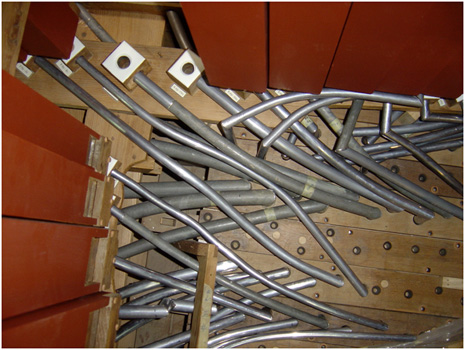
The windchests, which had supernaturally preserved their original toe boards (with forged nails), were completely restored for the first time after more than 160 years of use.
Posting had certainly never been taken off. Some had to be changed, victims of rats and time.
The layer of dust which recovered the whole elements was the measure of the three windchests' authenticity . After the toe boards were taken off, immense cracks were present on tables and their restoration by filling-in did not seem to be a long-lasting solution. It was necessary to change these tables. To guarantee the best behaviour of the works in time, it was decided to use the lime tree rather than the oak for the new tables. All the leathers were changed and the brass rubbed or changed if necessary. The wind boxes of pedal was enlarged to make way for the new valves F#2-F3. Naturally, the forged nails which was used in the original toe boards, refound their place.
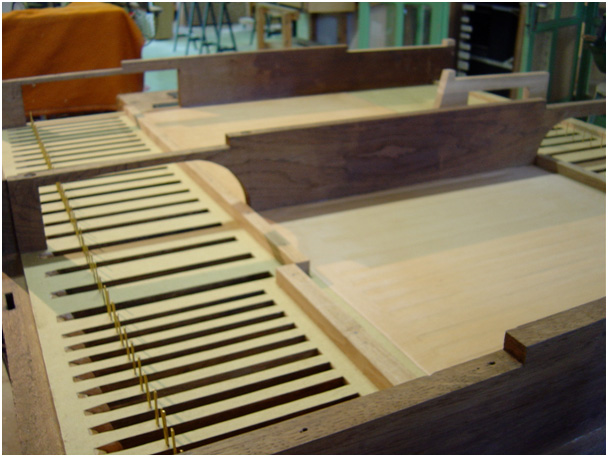
The action, completely original for the stops and for the notes (except for the mechanics pedal' wind boxes) was completely revised, the keyboards were restored and cleared , the shift coupling returned, the pedalboard redone. It is a straight German-style pedalboard in oak copied from the rare Callinet's pedalboard still in place; an adapted bench was also built.
Labels were redone according to those of Saint-Chef on laid paper.
The swell shutters of the Récit's swell box have the peculiarity to open towards the vault. They are activated by a drawstop and thus possess only two positions: opened, closed, where from the nickname of Récit-echo often given to Callinet's Récit.
The pedalcoupler's action, which had completely disappeared, consists of double pendulums which begin from the pedalboard in direction of the rollerframe, the whole completely new.

Of the "calling" system - "Grand Jeu" ventil, there were only few things left in the dismantling. The accurate observation of the remaining elements and of the organ's lower case, allowed to reconstitute this system which "calls" Trompette - Clairon - Chalumeau's trebble and Cornet's trebble.
An important work was also necessary to restore the case. This one wore the most visible stigmas of the previous interventions. The back panelling had wildly been cut just like the sides of the lower case. it had also been revarnished after the war in a darker tint. It was thus completely cleaned, verified in its assemblies and completed in copy for the missing elements, the whole thing was revarnished with Lac which used Callinet (information found in a line of an estimate).
The pipes of a very beautiful made, were in a particularly good state of preservation for the metal pipework and much more worrying for the wooden pipes. These, strongly attacked by worms had been, for some, covered with brown wrapping paper or painted with a thick brown painting to operate the waterproofness. They were restored, then coated with an ochre painting, similar to the one with which Callinet coated its bellows. Some pipes, too much damaged, were replaced by pipes in copy. All the faceboards' leathers were changed as well as those who recover blocks to operate the waterproofness at the foot of the wooden pipes.
The metal pipework was straightened to remove some bumps after wash, then some repairs were necessary (unsoldered ears, attack of some feet by rats)
The Bourdon which kept their original soldered canisters and the basses of Gambe removed by Négrel, carefully kept in the Presbytery and certainly not altered were precious elements to find the diapason of the organ. (A=430,6Hz in 15°C is A=433Hz in 18°C). Still it was necessary to find the pressure. Numerous tests were practised on various pipes taken in diverse stops and the obtained results were compared to what wrote Joseph Callinet to the council of Lons-le-Saunier. Namely that in a church of an important volume, Joseph Callinet gave to his instruments a more important pressure. The value of 95mm obtained by the tests was thus perfectly justified, here.
After the dismantling, the pipework was reclassified (inversions in the Mixture further to the reorganization of Négrel) and cleaned. More than 80 % of the original sound material reached us. The incomplete stops were completed by new pipes, made following the model of the organbuilder from Rouffach. Let us notice in the passage the very strong content of tin of the alloys : 96 % of tin for the "Principaux", the Gambes and the Reeds, 53 % for Flutes and Bourdon, both alloys containing some copper. Certain pipes, which had been slightly recut or damaged by successive tunings were lenghtened.
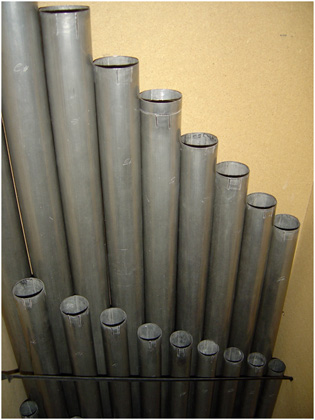
The two stops which had entirely disappeared are copies of stops existing in other Callinet's organs, just like the stop which had not been originally placed. Considering its place on the windchest (between the Basson-Chalumeau and the Clairon) and the holes of the toe board which correspond to that of a reed stop, it was decided to place a Cromhorn (spelling of Callinet).
The Trebble of the Chalumeau (Great-Organ) copied from that of Guémar ( 1843 ).
The Cromhorn (Great-Organ) copied from that of Lons-le-Saunier ( 1844 ).
The Voix humaine of the Récit copied from that of Sallanches ( 1850 ).
Some peculiarities of the pipework :
The blocked stops have a wooden bass until Eb above the 4' (Bourdon 16', Bourdon 8' GO and Récit, Flute 4'). The first octave of the Flute traversière 8' GO is also wooden (open). Veneers are fixed by forged nails on slices of scheepskin.
The dulciana of the Récit is a thin size stop, slightly conical with semi circular mouths. As all the fundamental stops of the Récit, this stop is in plain metal.
The trebble of the Chalumeau and the Hautbois are harmonics from F*4.
The first octaves of the Trumpet and the Basson have boxes in lathed lime tree.
The Basson has reeds in lathed pear tree of big size covered with a fine leather, in which is practised a square opening, on all its extent.
The "Fourniture" is composed as followed :
C1 C2 F2 C3 C#3 G3 C#4 F4 Bb4 C5
1 1/3 2 2/3 4 5 1/3
1 1 1/3 2 4
2/3 1 1 1/3 2 2 2/3 4
½ 1 1 1/3 2 2 2/3
1/3 2/3 1 1 1/3 2 2 2/3
The pedalboard extended to 30 notes by Négrel, the parallelisms on the reservoir and the electric blower for the wind supply are the only maintained later contributions, as planed by the works' program proposed by the advisor Mr Jean Pierre Decavèle, in charge of the project. As a precaution, the width of the tuning floors behind the organ was doubled and the fixings in the wall redone.
During the reassembly, the organ was moved forward on the gallery about 80 centimeters so finding the place which it occupied originally. The marks on the stone floor appeared during the dismantling, allowed to find this location without ambiguity.
The blower which was lying in the lower case of the organ during the dismantling was taken out of the case to be placed as closely as possible to the bellows in a new box, just like the wind regulating box which was redone.
The voicing phase was thus driven according to the diapason and the pressure found, remembering the rules of Joseph Callinet's voicing which he described in his estimate copied out and published by Meyer-Siat. The temperament is equal.